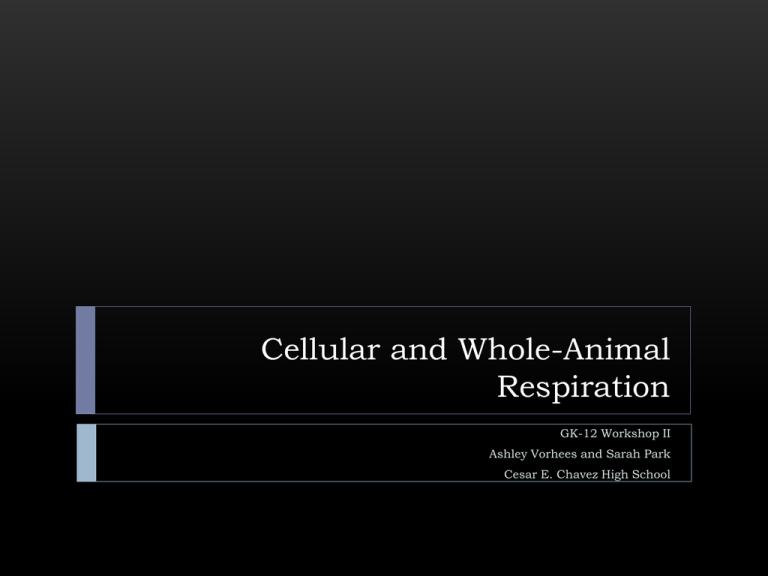Workshop Introduction - UCI - School of Biological Sciences
advertisement

Cellular and Whole-Animal Respiration GK-12 Workshop II Ashley Vorhees and Sarah Park Cesar E. Chavez High School Cricket Respiration Lab Students will measure oxygen consumption in crickets at different temperatures using simple respirometers. Water level Pipette Why teach this? Integrates into cell bio curriculum Why teach this? Integrates into cell bio curriculum Cell curriculum can be abstract and difficult to relate to Why teach this? Integrates into cell bio curriculum Cell curriculum can be abstract and difficult to relate to Students learn about cell functions in the context of whole-animal function Why teach this? Overview of Module I. Pre-Lab Lecture Notes II. Pre-Lab Worksheet III. Measuring oxygen consumption in crickets Follow-up Questions V. Effects of temperature on metabolism Lab Experiment IV. Cellular respiration Reinforce understanding of lab Extension Activity Extrapolating human MR from cricket MR I. Pre-Lab Notes II. Pre-Lab Activity III. Cricket Respiration Lab As cricket consumes O2, pressure inside chamber decreases O2 Water level Pipette O2 O2 O2 O2 KOH III. Cricket Respiration Lab As cricket consumes O2, pressure inside chamber decreases O2 Water level O2 Pipette O2 O2 KOH CO2 III. Cricket Respiration Lab As cricket consumes O2, pressure inside chamber decreases O2 Water level O2 Pipette O2 KOH CO2 CO2 III. Cricket Respiration Lab As cricket consumes O2, pressure inside chamber decreases O2 Water level Pipette O2 CO2 KOH CO2 CO2 III. Cricket Respiration Lab As cricket consumes O2, pressure inside chamber decreases O2 Water level Pipette CO CO2 2 KOH CO2 CO2 III. Cricket Respiration Lab Amount of water that enters pipette is directly proportional to amount of O2 consumed by the cricket Measure volume difference and divide by minutes MR = mL O2 per minute O2 Water level Pipette CO CO2 2 KOH CO2 CO2 IV. Data Collection IV. Data Collection Graph the results Should show linear increase in metabolic rate with temperature V. Extension Activity California Content Standards (7-8th) Grade Level Subject Standards Addressed Cell Biology 1.a. Students know cells function similarly in all living organisms. 1.d. Students know that mitochondria liberate energy for the work that cells do and that chloroplasts capture sunlight energy for photosynthesis. Structure and Function in Living Systems 5.a. Students know plants and animals have levels of organization for structure and function, including cells, tissues, organs, organ systems, and the whole organism. 5b. Students know organ systems function because of the contributions of individual organs, tissues, and cells. The failure of any part can affect the entire system. Investigation & Experimentation 7.a. Select and use appropriate tools and technology (including calculators, computers, balances, spring scales, microscopes, and binoculars) to perform tests, collect data, and display data. 7.c. Communicate the logical connection among hypotheses, science concepts, tests conducted, data collected, and conclusions drawn from the scientific evidence. 7th Grade Life Science California Content Standards (9-12th) Grade Level High School Biology Subject Standards Addressed Cell Biology 1.b. Students know enzymes are proteins that catalyze biochemical reactions without altering the reaction equilibrium and the activities of enzymes depend on the temperature, ionic conditions, and the pH of the surroundings. 1.g. Students know the role of the mitochondria in making stored chemicalbond energy available to cells by completing the breakdown of glucose to carbon dioxide. 1.i. Students know how chemiosmotic gradients in the mitochondria and chloroplast store energy for ATP production. Physiology 9.a. Students know how the complementary activity of major body systems provides cells with oxygen and nutrients and removes toxic waste products such as carbon dioxide. 1.a. Select and use appropriate tools and technology to perform tests, collect data, analyze relationships, and display data. 1.c. Identify possible reasons for inconsistent results, such as sources of error or uncontrolled conditions. Investigation & Experimentation 1.d. Formulate explanations by using logic and evidence. 1.j. Recognize the issues of statistical variability and the need for controlled tests. 1.l. Analyze situations and solve problems that require combining and applying concepts from more than one area of science. Prior Knowledge Materials Live crickets (large) Small vials Rubber stoppers Graduated pipettes (≤2mL) Cotton balls 15% KOH solution Water baths Thermometers Ice Timeline Day Activity 1 Pre-Lab Lecture Pre-lab Worksheet 2 Cricket Respiration Lab* Comprehension Questions 3 Graph data and discuss results Extension Activity *Needs to be completed in 1 day Assessment Fill-in Notes Pre-Lab Worksheet Data Table Comprehension Questions Extension Activity Today… Work in your RS/CT pairs 11:00-11:45 Set up and perform the cricket respiration experiment (Stations 1-4) 11:45-12:00 Walk-through of Extension Activity Extension Activity Purpose How Help students see connection between module content and their own physiology Estimate human metabolic rate based on cricket metabolic rate Reinforces concepts: Your cells use same cellular processes to make ATP as a cricket Body size (# of cells) determines how quickly you use energy What factors determine metabolic rate? 1. 2. 3. Temperature Phylogeny Body Mass Metabolic rate scales with body mass according to: MR = aM0.75 MR – metabolic rate M – body mass a – constant that depends on the animal in question Scaling of metabolic rate Mass = 10 g MR = 10 mL O2/min Mass = 20 g MR = 16.8 L O2/min MR = aM0.75 How can we use this equation? Two equations with 𝑎 and 𝑀𝑅𝐻𝑢𝑚𝑎𝑛 unknown. 𝑀𝑅𝐶𝑟𝑖𝑐𝑘𝑒𝑡 = 𝑎 𝑀𝐶𝑟𝑖𝑐𝑘𝑒𝑡 0.75 𝑀𝑅𝐻𝑢𝑚𝑎𝑛 = 𝑎 𝑀𝐻𝑢𝑚𝑎𝑛 0.75 Instead of having students solve both, we combine into one that uses a relative mass: 𝑀𝑅𝐻𝑢𝑚𝑎𝑛 = 𝑀𝐻𝑢𝑚𝑎𝑛 0.75 𝑀𝑅𝐶𝑟𝑖𝑐𝑘𝑒𝑡 𝑀𝐶𝑟𝑖𝑐𝑘𝑒𝑡 200,000 0.02 200,000 9457 189 0.02 0.4 0.0004 Temperature Body Mass Thank you!






